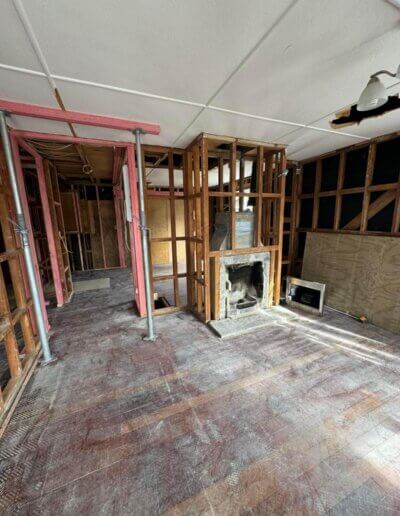CASE STUDY
Class B non-friable roof removal & void clean
Project:
Pro Environmental Services was recently tasked with an asbestos removal job in Naenae in the Lower Hutt. This involved friable asbestos mortar and chimney removal with a chimney deconstruction, including waste disposal.
Location
Rata Street, Naenae, Lower Hutt
Asbestos and chimneys
Fireboxes, flues, and chimneys were built with asbestos to be able to withstand prolonged periods of direct flame contact because the asbestos additives didn’t burn or distort – no matter how hot they got. Ordinary clay and concrete bricks couldn’t handle such temperatures for extended periods of time.
That means some older Lower Hutt and other New Zealand homes were built with firebricks and mortar that contained up to 80 percent asbestos.This is a hazard to homeowners who are getting their chimneys cleaned each year as there is a high risk of disturbing asbestos containing materials, which increases chances of exposure and cross contamination.
Asbestos refers to a group of fibrous materials that are naturally occurring. These fibrous materials have high tensile strength and flexibility, and they used to be widely used for roofing because they are resistant to heat, chemicals, and electricity. While they are no longer allowed to be used in building materials in New Zealand, plenty of older properties still exist that contain asbestos.

The asbestos removal process
Class A asbestos is the friable kind of asbestos. In other words, it is very prone to crumbling and releasing its dangerous fibres into the environment. As a class A asbestos removalist working across Wellington, Palmerston North, and the Kapiti Coast, PRO Environmental Services is well equipped to safely remove this material.
First, we had to create an enclosure around the chimney as a safe working space. To build the enclosure we used timbers, polythene sheets, tape, staples, and screws. We connected cubes andNPU. We did a smoke test to make sure the enclosure was airtight with no leaks before starting work. We used basic removal tools and had to bring a big breaker to break the chimney down.
We first cleaned all the waste materials, then double bagged them prior to leaving the enclosure. Then we used an industrial H-type vacuum to clean the area, and wiped down the entire enclosure with sugar soap.
An independent assessor then carried out a final inspection with a surface and air test to declare the site safe.
Class B asbestos is non-friable, which means that it is not prone to crumbling. However, it can still pose a danger and must be removed by professionals:
To complete the removal, we used hammers, nail puller bars, crowbars, drill and bolt cutters. Our trained operators removed the roofing material sheet by sheet,and immediately put those sheets into hazmat bags. All insulation from the roof was bagged and passed also straight down into the hazmat bag.
We again used the industrial vacuum and sugar soap to clean the area afterwards. And our expert team passed the site inspection with flying colours as always!
In all, we completed the Class A removal in just 3 days, and the class B removal in 3 days as well. We only deconstructed the enclosure after all the site test results came back negative for traces of asbestos.





